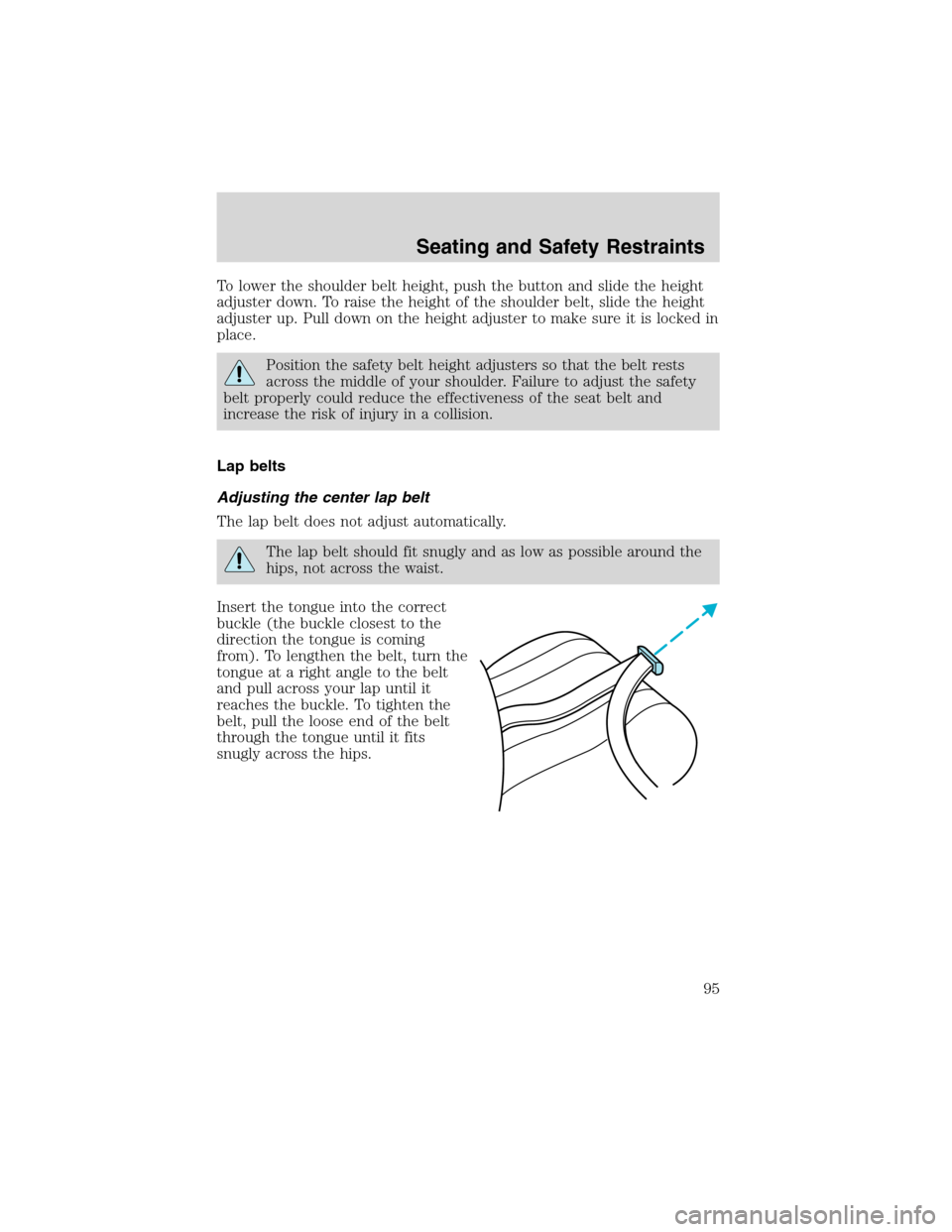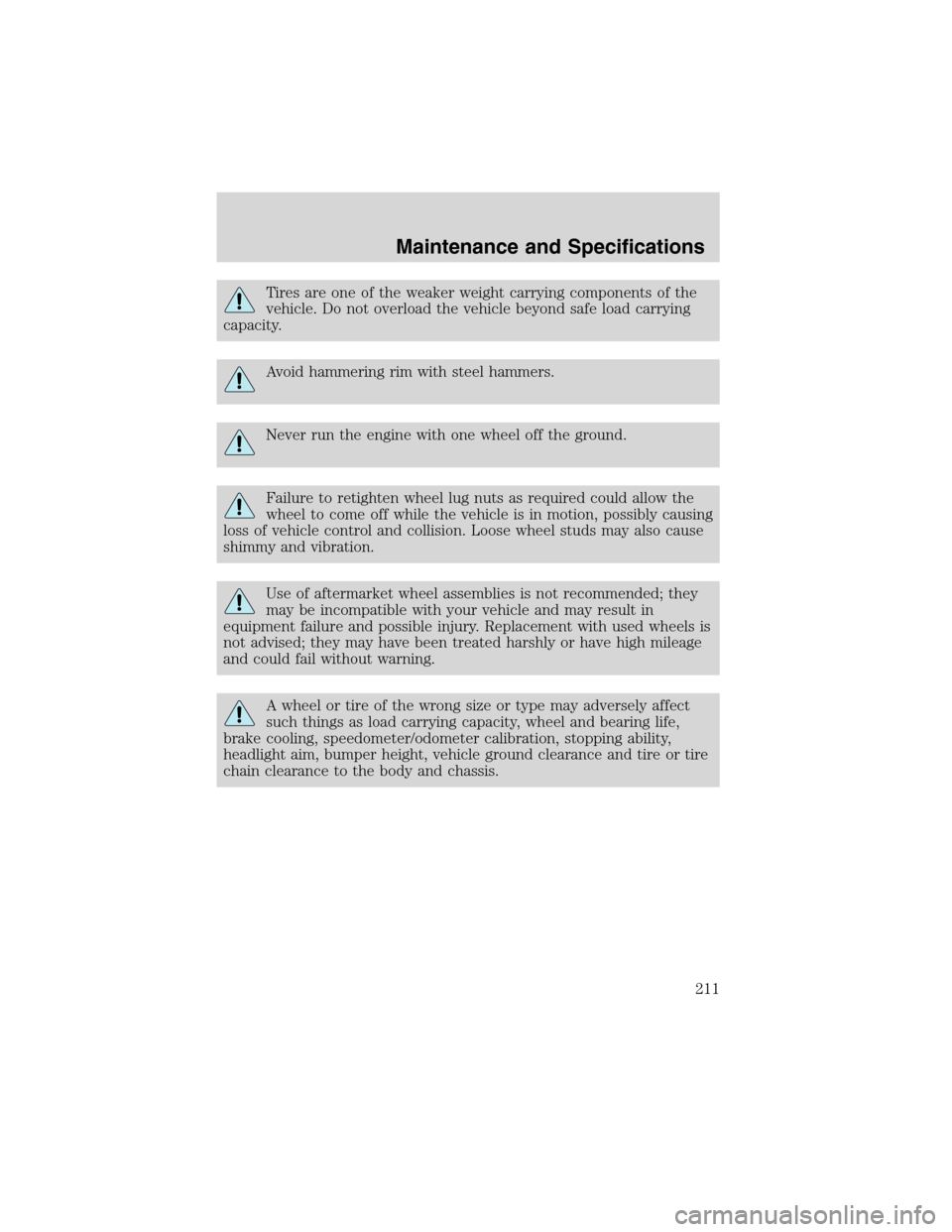height FORD F650 2003 10.G Owners Manual
[x] Cancel search | Manufacturer: FORD, Model Year: 2003, Model line: F650, Model: FORD F650 2003 10.GPages: 248, PDF Size: 2.54 MB
Page 88 of 248

Pump handle to raise seat height.
Push handle full down to lower.
Always adjust the seat height
beforefastening seatbelt.
Air-Ride seat (if equipped)
Push up on the switch to raise the
seat height.
Press down on the switch to lower
the seat height.
Always adjust the seat heightbeforefastening seatbelt.
Press up on the switch to increase
the firmness of the seatback.
Seating and Safety Restraints
88
Page 93 of 248

Combination lap and shoulder belts
1. Insert the belt tongue into the
proper buckle (the buckle closest to
the direction the tongue is coming
from) until you hear a snap and feel
it latch. Make sure the tongue is
securely fastened in the buckle.
2. To unfasten, push the release
button and remove the tongue from
the buckle.
The front and rear outboard safety restraints in the vehicle are
combination lap and shoulder belts. The front and rear seat passenger
outboard safety belts have vehicle sensitive emergency locking retractors.
Vehicle sensitive retractor
The vehicle sensitive retractor allows free shoulder belt length
adjustment to your movements and locks in response to vehicle
movement. For example, if the driver brakes suddenly or turns a corner
sharply, or the vehicle receives an impact of approximately 8 km/h
(5 mph) or more, the combination safety belts will lock to help reduce
forward movement of the driver and passengers.
Front safety belt height adjustment
SuperCab and CrewCab vehicle has safety belt height adjustments for
the driver and front passenger. Adjust the height of the shoulder belt so
the belt rests across the middle of your shoulder.
Seating and Safety Restraints
93
Page 95 of 248

To lower the shoulder belt height, push the button and slide the height
adjuster down. To raise the height of the shoulder belt, slide the height
adjuster up. Pull down on the height adjuster to make sure it is locked in
place.
Position the safety belt height adjusters so that the belt rests
across the middle of your shoulder. Failure to adjust the safety
belt properly could reduce the effectiveness of the seat belt and
increase the risk of injury in a collision.
Lap belts
Adjusting the center lap belt
The lap belt does not adjust automatically.
The lap belt should fit snugly and as low as possible around the
hips, not across the waist.
Insert the tongue into the correct
buckle (the buckle closest to the
direction the tongue is coming
from). To lengthen the belt, turn the
tongue at a right angle to the belt
and pull across your lap until it
reaches the buckle. To tighten the
belt, pull the loose end of the belt
through the tongue until it fits
snugly across the hips.
Seating and Safety Restraints
95
Page 100 of 248

8. Confirmation of enabling BeltMinder is provided by:
•The safety belt warning light flashing four times per second for three
seconds.
•Followed by three seconds with the safety belt warning light off.
•Once again, the safety belt warning light will flash four times per
second for three seconds.
9. After receiving confirmation, the deactivation/activation procedure is
complete.
Safety belt extension assembly
If the safety belt is too short when fully extended, there is a 20 cm
(8 inch) safety belt extension assembly that can be added (part number
611C22). This assembly can be obtained from your dealer at no cost.
Use only extensions manufactured by the same supplier as the safety
belt. Manufacturer identification is located at the end of the webbing on
the label. Also, use the safety belt extension only if the safety belt is too
short for you when fully extended.
Do not use extensions to change the fit of the shoulder belt
across the torso.
Safety belt maintenance
Inspect the safety belt systems periodically to make sure they work
properly and are not damaged. Inspect the safety belts to make sure
there are no nicks, tears or cuts. Replace if necessary. All safety belt
assemblies, including retractors, buckles, front seat belt buckle
assemblies, buckle support assemblies (slide bar-if equipped), shoulder
belt height adjusters (if equipped), shoulder belt guide on seatback (if
equipped), child safety seat tether anchors, and attaching hardware,
should be inspected after a collision.
Ford Motor Company recommends that all safety belt assemblies
used in vehicles involved in a collision be replaced. Safety belt
assemblies not in use during a collision should also be inspected and
replaced if either damage or improper operation is noted.
Failure to inspect and if necessary replace the safety belt
assembly under the above conditions could result in severe
personal injuries in the event of a collision.
Refer toCleaning and maintaining the safety beltsin theCleaning
chapter.
Seating and Safety Restraints
100
Page 131 of 248
![FORD F650 2003 10.G Owners Manual •Total vehicle out of alignment (i.e. rear axle[s] out of alignment with
front axle)
•Improper adjustment in the steering gear
•Vehicle overloaded or unevenly loaded
•High crosswinds
•High c FORD F650 2003 10.G Owners Manual •Total vehicle out of alignment (i.e. rear axle[s] out of alignment with
front axle)
•Improper adjustment in the steering gear
•Vehicle overloaded or unevenly loaded
•High crosswinds
•High c](/img/11/5069/w960_5069-130.png)
•Total vehicle out of alignment (i.e. rear axle[s] out of alignment with
front axle)
•Improper adjustment in the steering gear
•Vehicle overloaded or unevenly loaded
•High crosswinds
•High crown in center of road
•Components in steering linkage loose or worn
•Wheel bearings improperly adjusted
•Excessive lash in steering shaft or universal joints
If the vehicle steers hard
Hard steering can be caused by any of the following conditions:
•Underinflated tire(s) on any wheel(s)
•Vehicle overload
•Misalignment of the front tires
•Lack of lubricant in the front spindle bearings or linkage components
•Low oil level in the power steering system
•Broken or loose power steering pump direct drive connection
•Malfunctioning relief valve in power steering gear or steering pump
•Malfunctioning power steering pump
•Restriction in power steering lines
•Improperly set turn stops
•Air entrapped in power steering system fluid
AIR SUSPENSION SYSTEM (IF EQUIPPED)
The on-highway air suspension system is designed to provide a superior
ride, outstanding driver comfort while minimizing wear on the cab, frame
and payload.
The height control valve automatically keeps the vehicle at a constant
level due to load changes and uneven road surfaces.
Air suspension-equipped vehicles are equipped with a dryer module
which needs to be opened monthly to remove moisture from the system.
Driving
131
Page 211 of 248

Tires are one of the weaker weight carrying components of the
vehicle. Do not overload the vehicle beyond safe load carrying
capacity.
Avoid hammering rim with steel hammers.
Never run the engine with one wheel off the ground.
Failure to retighten wheel lug nuts as required could allow the
wheel to come off while the vehicle is in motion, possibly causing
loss of vehicle control and collision. Loose wheel studs may also cause
shimmy and vibration.
Use of aftermarket wheel assemblies is not recommended; they
may be incompatible with your vehicle and may result in
equipment failure and possible injury. Replacement with used wheels is
not advised; they may have been treated harshly or have high mileage
and could fail without warning.
A wheel or tire of the wrong size or type may adversely affect
such things as load carrying capacity, wheel and bearing life,
brake cooling, speedometer/odometer calibration, stopping ability,
headlight aim, bumper height, vehicle ground clearance and tire or tire
chain clearance to the body and chassis.
Maintenance and Specifications
211